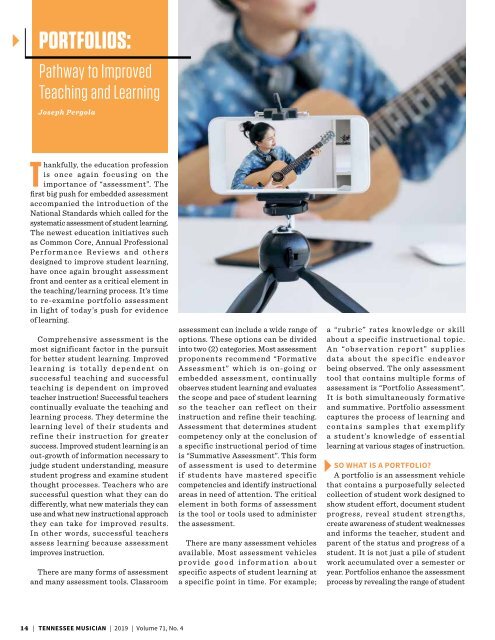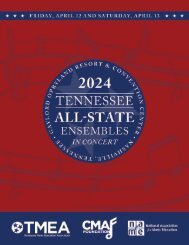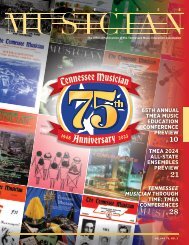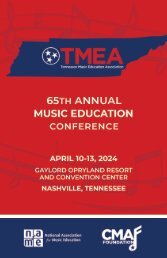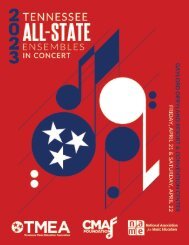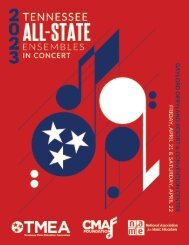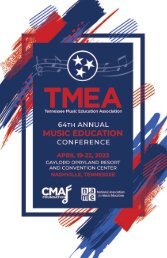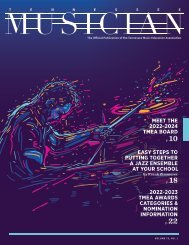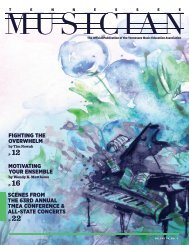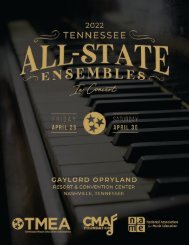TN Musician Vol. 71 No. 4
Create successful ePaper yourself
Turn your PDF publications into a flip-book with our unique Google optimized e-Paper software.
PORTFOLIOS:<br />
Pathway to Improved<br />
Teaching and Learning<br />
Joseph Pergola<br />
T<br />
hankfully, the education profession<br />
is once again focusing on the<br />
importance of “assessment”. The<br />
first big push for embedded assessment<br />
accompanied the introduction of the<br />
National Standards which called for the<br />
systematic assessment of student learning.<br />
The newest education initiatives such<br />
as Common Core, Annual Professional<br />
Performance Reviews and others<br />
designed to improve student learning,<br />
have once again brought assessment<br />
front and center as a critical element in<br />
the teaching/learning process. It’s time<br />
to re-examine portfolio assessment<br />
in light of today’s push for evidence<br />
of learning.<br />
Comprehensive assessment is the<br />
most significant factor in the pursuit<br />
for better student learning. Improved<br />
learning is totally dependent on<br />
successful teaching and successful<br />
teaching is dependent on improved<br />
teacher instruction! Successful teachers<br />
continually evaluate the teaching and<br />
learning process. They determine the<br />
learning level of their students and<br />
refine their instruction for greater<br />
success. Improved student learning is an<br />
out-growth of information necessary to<br />
judge student understanding, measure<br />
student progress and examine student<br />
thought processes. Teachers who are<br />
successful question what they can do<br />
differently, what new materials they can<br />
use and what new instructional approach<br />
they can take for improved results.<br />
In other words, successful teachers<br />
assess learning because assessment<br />
improves instruction.<br />
There are many forms of assessment<br />
and many assessment tools. Classroom<br />
assessment can include a wide range of<br />
options. These options can be divided<br />
into two (2) categories. Most assessment<br />
proponents recommend “Formative<br />
Assessment” which is on-going or<br />
embedded assessment, continually<br />
observes student learning and evaluates<br />
the scope and pace of student learning<br />
so the teacher can reflect on their<br />
instruction and refine their teaching.<br />
Assessment that determines student<br />
competency only at the conclusion of<br />
a specific instructional period of time<br />
is “Summative Assessment”. This form<br />
of assessment is used to determine<br />
if students have mastered specific<br />
competencies and identify instructional<br />
areas in need of attention. The critical<br />
element in both forms of assessment<br />
is the tool or tools used to administer<br />
the assessment.<br />
There are many assessment vehicles<br />
available. Most assessment vehicles<br />
provide good information about<br />
specific aspects of student learning at<br />
a specific point in time. For example;<br />
a “rubric” rates knowledge or skill<br />
about a specific instructional topic.<br />
An “observation report” supplies<br />
data about the specific endeavor<br />
being observed. The only assessment<br />
tool that contains multiple forms of<br />
assessment is “Portfolio Assessment”.<br />
It is both simultaneously formative<br />
and summative. Portfolio assessment<br />
captures the process of learning and<br />
contains samples that exemplify<br />
a student’s knowledge of essential<br />
learning at various stages of instruction.<br />
SO WHAT IS A PORTFOLIO?<br />
A portfolio is an assessment vehicle<br />
that contains a purposefully selected<br />
collection of student work designed to<br />
show student effort, document student<br />
progress, reveal student strengths,<br />
create awareness of student weaknesses<br />
and informs the teacher, student and<br />
parent of the status and progress of a<br />
student. It is not just a pile of student<br />
work accumulated over a semester or<br />
year. Portfolios enhance the assessment<br />
process by revealing the range of student<br />
14 | TENNESSEE MUSICIAN | 2019 | <strong>Vol</strong>ume <strong>71</strong>, <strong>No</strong>. 4


